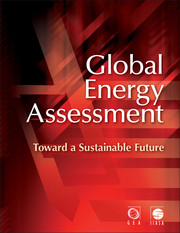Book contents
- Frontmatter
- Contents
- Section 1
- Section 2
- Section 3
- Cluster 1
- Cluster 2
- Chapter 7 Energy Resources and Potentials
- Chapter 8 Energy End-Use: Industry
- Chapter 9 Energy End-Use: Transport
- Chapter 10 Energy End-Use: Buildings
- Chapter 11 Renewable Energy
- Chapter 12 Fossil Energy
- Chapter 13 Carbon Capture and Storage
- Chapter 14 Nuclear Energy
- Chapter 15 Energy Supply Systems
- Chapter 16 Transitions in Energy Systems
- Cluster 3
- Cluster 4
- Section 4
- Index
- References
Chapter 8 - Energy End-Use: Industry
Published online by Cambridge University Press: 05 September 2012
- Frontmatter
- Contents
- Section 1
- Section 2
- Section 3
- Cluster 1
- Cluster 2
- Chapter 7 Energy Resources and Potentials
- Chapter 8 Energy End-Use: Industry
- Chapter 9 Energy End-Use: Transport
- Chapter 10 Energy End-Use: Buildings
- Chapter 11 Renewable Energy
- Chapter 12 Fossil Energy
- Chapter 13 Carbon Capture and Storage
- Chapter 14 Nuclear Energy
- Chapter 15 Energy Supply Systems
- Chapter 16 Transitions in Energy Systems
- Cluster 3
- Cluster 4
- Section 4
- Index
- References
Summary
Executive Summary
The industrial sector accounts for about 30% of the global final energy use and accounts for about 115 EJ of final energy use in 2005. Cement, iron and steel, chemicals, pulp and paper and aluminum are key energy intensive materials that account for more than half the global industrial use.
There is a shift in the primary materials production with developing countries accounting for the majority of the production capacity. China and India have high growth rates in the production of energy intensive materials like cement, fertilizers and steel (12–20%/yr). In different economies materials demand is seen to grow initially with income and then stabilize. For instance in industrialized countries consumption of steel seems to saturate at about 500 kg/ capita and 400–500 kg/capita for cement.
The aggregate energy intensities in the industrial sectors in different countries have shown steady declines – due to an improvement in energy efficiency and a change in the structure of the industrial output. As an example for the EU-27 the final energy use by industry has remained almost constant (13.4 EJ) at 1990 levels. Structural changes in the economies explain 30% of the reduction in energy intensity with the remaining due to energy efficiency improvements.
In different industrial sectors adopting the best achievable technology can result in a saving of 10–30% below the current average. An analysis of cost cutting measures for motors and steam systems in 2005 indicates energy savings potentials of 2.2 EJ for motors and 3.3 EJ for steam.
- Type
- Chapter
- Information
- Global Energy AssessmentToward a Sustainable Future, pp. 513 - 574Publisher: Cambridge University PressPrint publication year: 2012
References
- 7
- Cited by



